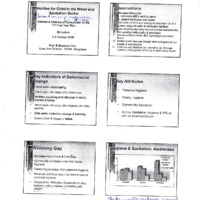Priorities for Child In the Water and Sanitation Sector
Item
- Title
-
Priorities for Child In the Water and
Sanitation Sector - extracted text
-
SDA-RF-CH-1B.10
Ki
-------------------
Observations
priorities for Child In the Water and
Sanitation Sector
A.-AHocu!ed Money for
''^1 S°ft sk*tls (lEC) not fully spent
Proie<^ hardware over spent
g^lismalch of time and energy in execution of i & ii
Crower usage of water & sanitation facilities
O^lack of understanding on post project sustainability
c. Not satisfied with quality & adequacy
F. Intensive Mass Media IEC Campaigns provided
Boost
G. Behavioural changes though slow and gradual but
steady & sustainable
H Children and Mothers not identified as Change
Leaders (not agents) at family & community levels
Karnataka Slate Level Consulddion on the
11,h Five Year Plan
Bangalore
5-6 October 2006
Prof. B Bhaskara Rao.
Executive Director ■ STEM. Bangalore
^ey Indicators of Behavioural
||bhange
ey Attributes
Hand wash before eating
r|
Hand wash with soaP after defecation
pi Mothers practicing safe disposal of child's
k -’1 excreta in toilets
I
•
Personal Hygiene
’
family Hygiene
•
Hand wash with soap after disposal of child's
excreta
•
Community Sanitation
•
Safe water: collection, storage & handling
•
•
Construction & Usage of toilets
School Sanitation, Hygiene & WS as
well as local institutions
'
'■
'
'
'
•
■
-
■■
■■
iWidening Gap
1 w
—■
hygiene & Sanitation: Awareness
||| Between Awareness & Practices
||g Community sanitation less than family
hygiene
f
Family hygiene less than personal hygiene
Personal practices less than awareness of
personal hygiene
Perceptions, Attitudes, Expectations vary
between policy makers, providers and
people
OHHs Need loti
Imfiwemert
75
' flz25
‘
_
s:
0
IB
IP"
ftrsmaltyjme
tes
»i
Fan* Hygiene
OHHs Need some
Impnxemert
OHHs-Good/ExceHert
ComnnlyHyjme
1
^Behavioural Improvements in
y .^Sanitation & Hygiene
1—___
•
j
(%o< FopuMOon/HH*)
> g. <
V>*
a«4
n CM
KAI’
7#"
•
QRV
1-1
■g-i—
• . 5faarw»g h*«3»’■•*’*°* d,w
Of
----- F-
-- ----- --- —
-
OsooMicI cMnwcTWawiMiaiw
wo* wsfTioap dfw o .w »m<
. _<!» tMtf »»*«««------------------------------• Ws-jwyj nmxm w<n»oao!»»ofi>pa«a
it
•.VI
C««t
Improvements in Sanitation &
Hygiene Behaviour
‘
.-J
NG
» —4 r «—it "
cw- —»»
[ ° ** *l>**r
VMS Cfew'offySiMtfylDoo. 2004)
J***1
|
Si 7l
ulCM <[— /lA
-Uy fftU- •Skvo
-----1------- —------------------ —-------------------------
giene Practices among School
lildren and Community
^Assessment
Compawiaon of KAP on HHL»
Awar«n«>> of
!■»•>« o«wn logo*
. J
n»ywi»m
BHfi
k'-M
20
yw0
10
2' ; Use ol latrines for defecation
‘3. .Washing hands with soap
*:■
after defecation__________ _
4, .' Brushing teeth everyday
•5. -> Clipping nails regularly______
8. 1 Hygiene practices learnt from
« Mother___________________
» Teachers_________________
• IEC material
_______(book labels)___________
comtetWU
|8I
Parameters
I^BKxistiixi HHLs
v...
•
SAS *04
KAP Study In
KAP Study among
Communities (%)
School Children (%)
31_____________18________
27__________
38______________
38
83
95
95
70
32
17
Not CHptund in gonaral KAP Study
Awareness & practice of good hygiene habits among school
children are higher than the community level, contrary to popular
belief
Focus on optimum conversion of willingness to usage
Is
MfW?__ __
.....
^Recommendations
^^Recommendations (contd.)
■w Develop suitable strategy to ensure that
garget children, adolescent girls and young
/I mothers for behaviour change through
3 hygiene education which may be achieved
k
sanitation for ail by 2012 can bb met by the
state.
i Develop and provide road map for sanitation
coverage based on diverse geographical
' |'’:3 conditions.
||
si
) Government subsidy need not be standard
across the district
• 2 Ensure all institutions private and public
meet standards for sanitation and hygiene.
Non compliance with these standards would
lead to disincentives.
f
through:
Campaigns/Jatha Yatras/lnterpersonnel communication
Sensitize Gram Panchayat
Promote hands on activities in the school curriculum .
Allocation of time in schools for sanitation activities
Encourage participatory and analytical approach to problems on
sanitation.
Clearance for construction of schools,
anganwadis and health centres subject to
adequate sanitation infrastructure.
2
ecommendations (contd.)
-
responsibility to be assigned to
M institution heads, as this is the weakest link
in sanitation.
Envelop suitable strategy for water scarcity
I and drought mitigation at the regional level.
WS&S programme to shift to Quality &
Adequacy
Common thinking & Change Management
Programme for all stakeholders
*
3
- Media
 SDA-RF-CH-1B.10.pdf
SDA-RF-CH-1B.10.pdf
Position: 6148 (1 views)
